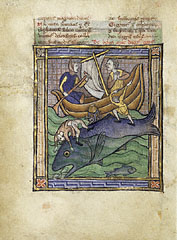• What do you think is happening in this image? What do the expressions on the faces of the men tell you about what is happening?
• What can you see on this page that tells you that it is part of a book?
• This page is from a book called a bestiary, or book of beasts. It is filled with stories that teach moral lessons through images of real and imaginary beasts. What do you think the moral lesson of this story might be?
• Are there any other stories you can think of that were created to teach lessons? (Possibly fables by Aesop, folktales, or parables.)
• Compare illustrated books from today to this manuscript that was written over 700 years ago. In what ways are they similar? In what ways are they different?
See more pages from this book. |
The bestiary, or book of beasts, is a collection of moralizing descriptions of animals both real and legendary. These books were especially popular during the 1100s and 1200s. A pseudo-scientific catalogue, the bestiary was based on an ancient Greek text. Originally compiled in the first centuries of the Christian era, translated into Latin in the 300s, and augmented throughout the Middle Ages, a bestiary explained the natural world in terms of Christian symbolism and principles.
The description of the "apsidochelone" (probably a whale) that is depicted on this page of a medieval bestiary is a fantastic concoction of nature and legend, all in the service of Christian teaching. One characteristic of the large sea creature noted in the bestiary is its tendency to remain motionless for long periods of time with its back just above the water line, fooling sailors into believing it is an island. Later, as the text relates, when the sailors set up camp on its back and light their campfires, the monster feels the heat and plunges suddenly into the watery depths. The whale is thereby understood allegorically as the wily devil that deceives sinners, ultimately plunging them into the fires of Hell.
The artist of the miniatures focused on the dramatic moment of realization. While the sailors' broad faces express fear, one victim tumbles over with acrobatic flair and another man barely holds onto the boat. To suggest movement, the artist sets up a play of related curves and angles throughout the composition. For example, the improbably curved left arm of the man clinging to the boat echoes the arc of the wind-filled sail, and his legs conform to the diagonal of the mast.
The Getty Museum's manuscript includes two rare treatises by Hugo de Fouilloy in addition to the bestiary. The first text is the Aviary, which uses the characteristics of different types of birds to make moral points. The second, a Treatise on Flocks and Shepherds, constructs a metaphorical discussion of Christ as an abbot, taking care of his flock, and the abbot and monks in a monastery caring for their charges. Both of Hugo's Latin texts were intended for teaching lay brothers, those who performed manual work in a monastery. |
